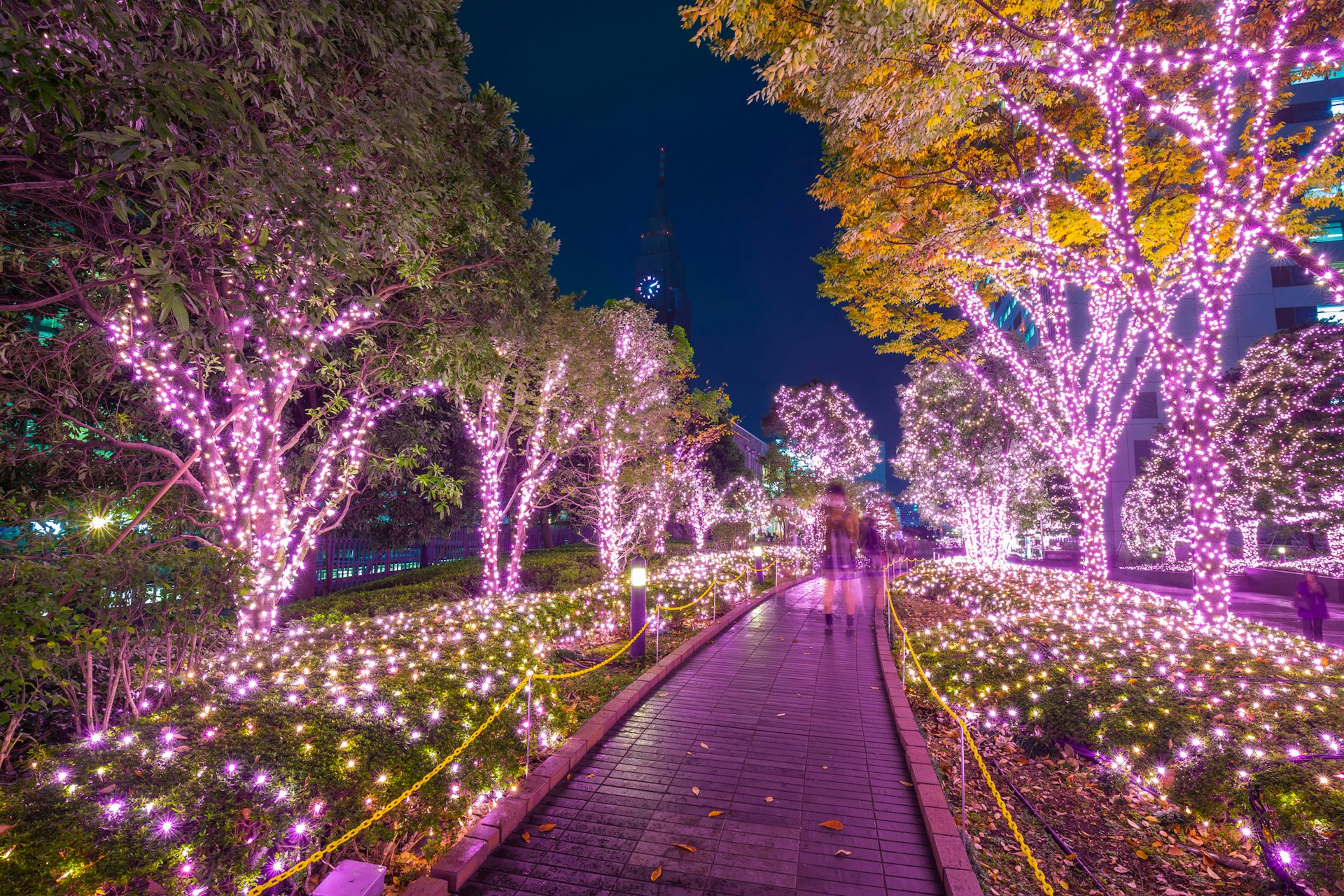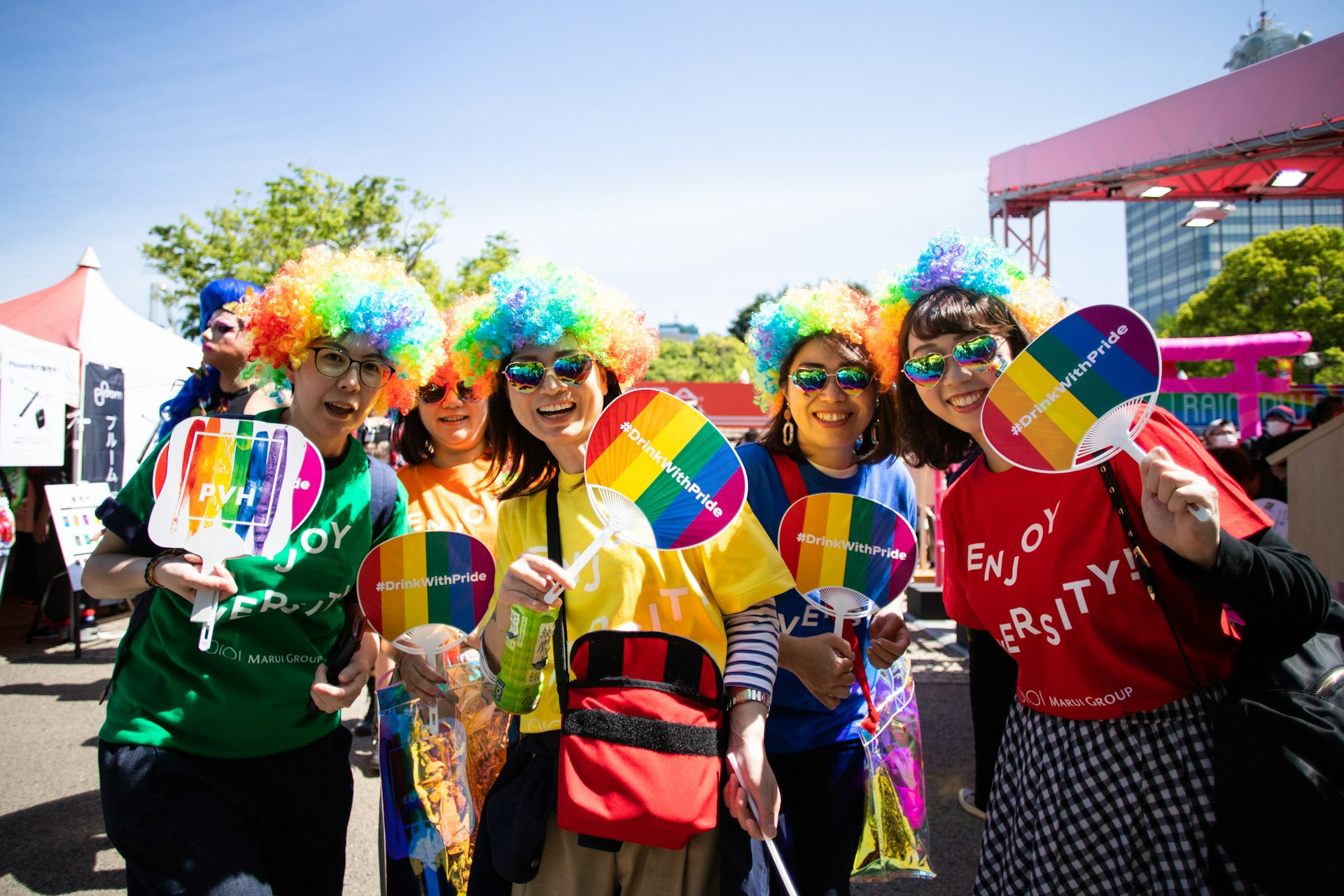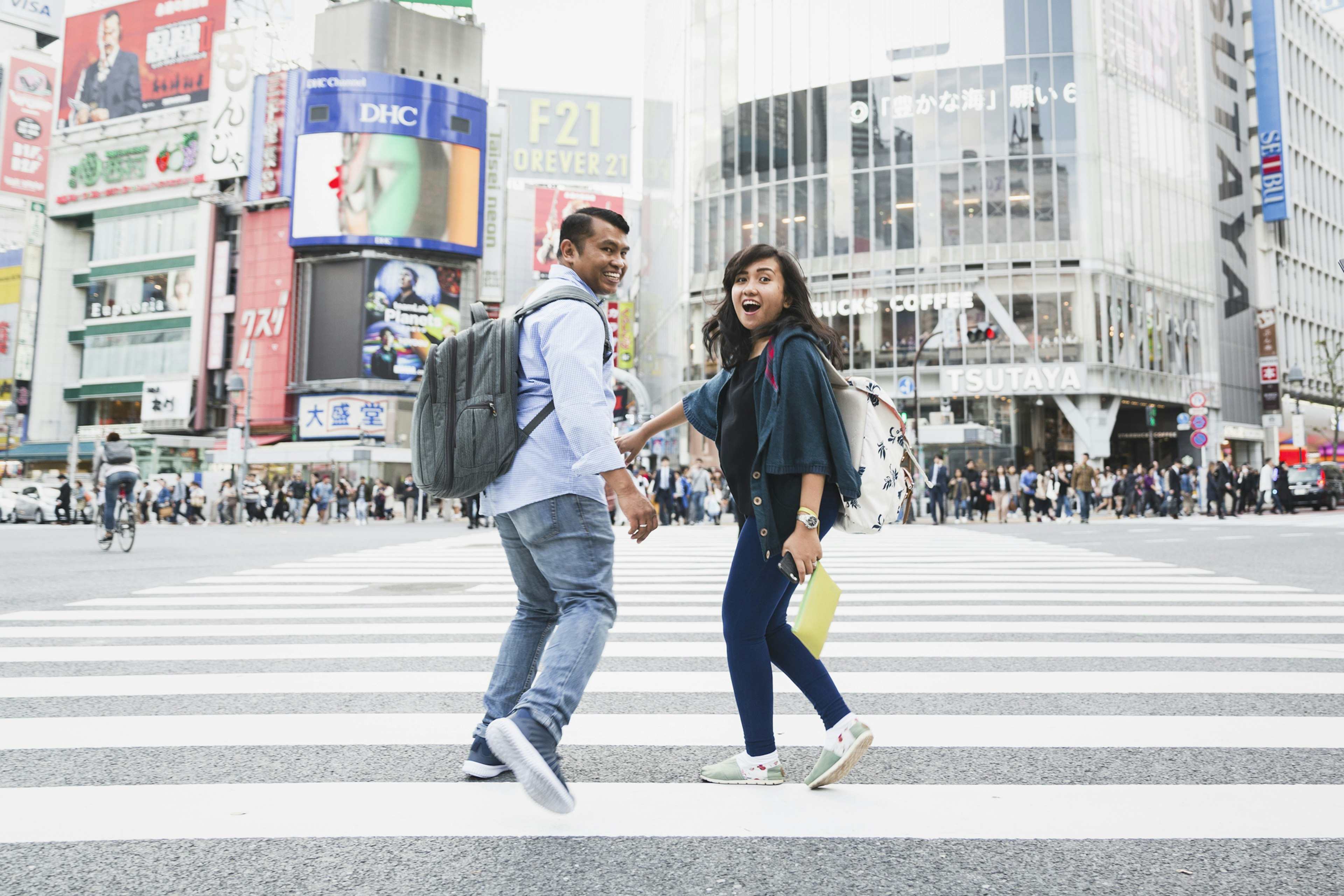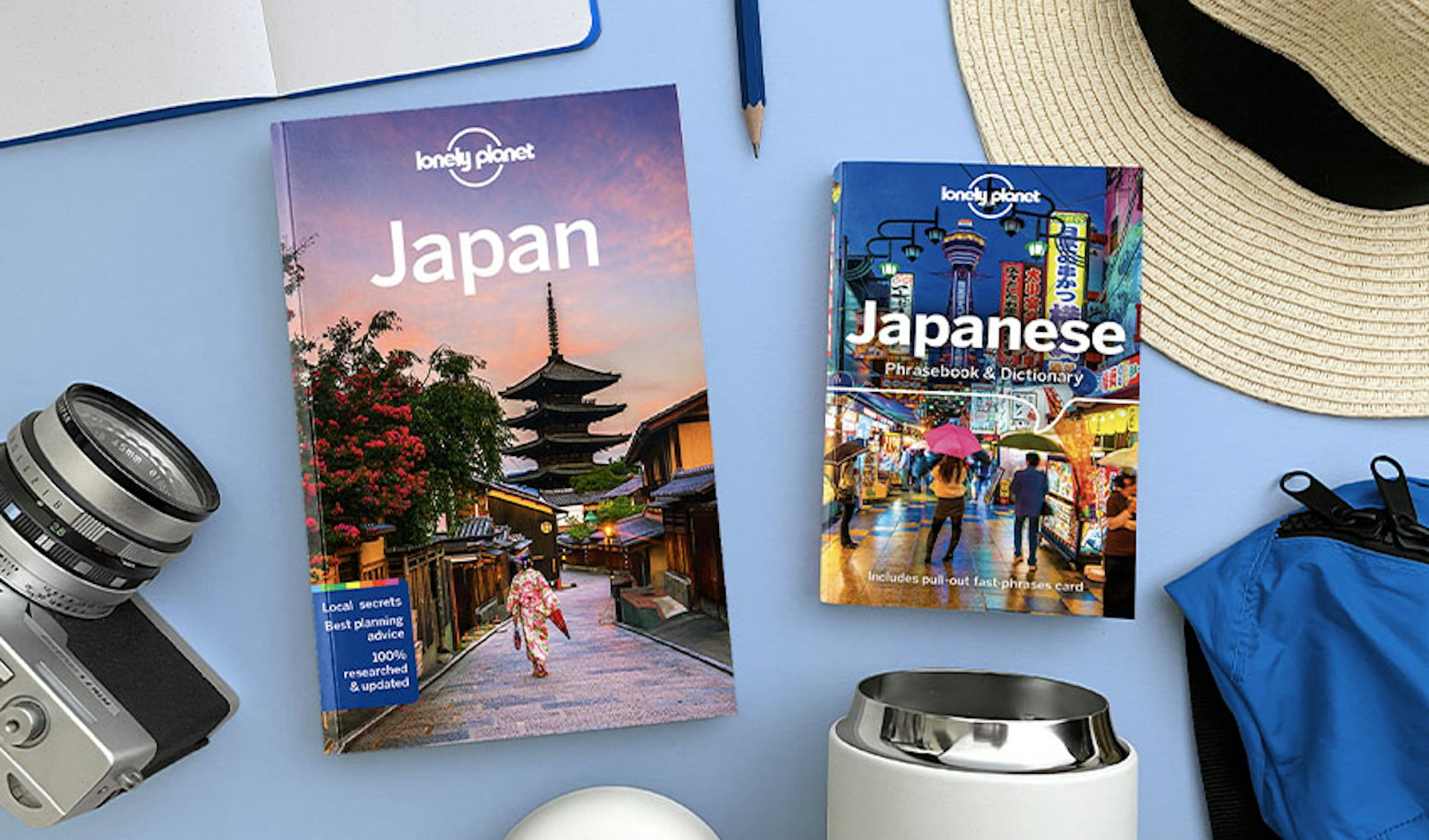Always dynamic, Tokyo shows a new side to its character with each passing season. There's really no bad time to visit. Spring and fall bring great weather for sightseeing and seasonal changes in foliage – hanami (flower viewing) in spring and momijigari (leaf-viewing) in autumn – that are followed by locals with giddy enthusiasm. In summer people gather to watch giant firework displays light up the night sky, and in winter, there are fewer crowds, festive illuminations, and snow-clad Mt Fuji is at its most beautiful.
Whether you’re hoping to catch Japan’s capital at its most lively or simply avoid the tourist crowds, here’s our guide to the best time to visit Tokyo.

There are several high seasons throughout the year
As Japan’s travel appeal has grown in popularity (it witnessed record-breaking annual tourism figures every year from 2012 to 2019, peaking at 32 million visitors) the high seasons have expanded outwards with it; nowhere has this been more apparent than in the major cities, particularly Tokyo and Kyoto. While the capital is sprawling enough to accommodate such an influx, Tokyo’s premier attractions are noticeably more thronged for significant stretches of the year as a result. But usually, it’s with good reason.
March to May is when you can see cherry blossoms in bloom
March to May is peak season in Tokyo, with great weather and riots of color in city parks thanks to the famous cherry blossom bloom. Locals and visitors gather for open-air picnics and parties, called hanami, to take in the natural splendor. The month of May is also marked by Ōgon Shūkan (Golden Week), which sees a number of significant holidays take place, giving the city an added buzz. Expect plenty of crowds, jam-packed trains and a spike in accommodation costs.
Mt Fuji hiking routes open in late-July to August, and summer festivals begin
Despite the chance of late-summer rains, energy-sapping humidity in August, and roaring typhoons in fall, a second tourism peak comes in late July and continues more or less unabated until December
Mt Fuji’s hiking routes are open during July and August, attracting pilgrims and summiters in their stick-wielding droves, while firework-fuelled summer festivals keep people entertained in the city.
September to November is the best time for moon-viewing and fall foliage
Clear skies around the autumn equinox in September call for tsukimi (moon-viewing gatherings), another quintessentially Japanese pastime. Plenty of big events also take place at this time, including the Tokyo Film Festival and extravagant Halloween celebrations in October.
The temperature cools to agreeable levels as Tokyo moves through the fall, paving the way for the koyo (autumn foliage) phenomenon. In November, the city’s parks, gardens, and high streets are painted in fiery hues as deciduous trees – ginkgo, momiji, maple, zelkova, and more – bid their leaves adieu. Some gardens, like Rikugi-en in the north, illuminate the falling leaves after dark.

Low season (December to February and June to July) is the best time for avoiding the crowds
Tokyo is quiet during the winter period, with the exception of the latter half of December when locals head out to end-of-year work parties and get-togethers. This is, however, a good time to see the city decked out in dazzling winter lights, and observe religious ceremonies in full swing at temples and shrines during Shōgatsu (the Japanese New Year) at the beginning of January.
Accommodation prices are generally low during this period and crowds are thin. However, it’s worth noting many businesses close over the New Year period. It’s also quite cold, though frequent clear blue skies mean snow-decked Mt Fuji is particularly beautiful at this time of year.
The height of the rainy season, usually arriving in mid-June to mid-July, is another low season for tourism in Tokyo, but the damp conditions are not great for sightseeing.
January is the time to buy good luck charms at shrines
Tokyo falls eerily quiet for Shōgatsu, the first three days of the Japanese New Year, which are set aside for family time and rest; most places close, sometimes for the whole week. Things stay pretty quiet all month, actually. Temples and shrines, including Meiji-jingū, are the exception; many get very busy as people make their first visit of the year, a ritual known as Hatsu-mōde, often purchasing omamori (good luck charms) whilst they’re at it.
Key events: Emperor’s New Year Greeting, Hatsu-mōde.
February is Tokyo's coldest month
February is the coldest month; crisp and clear with only the rare dusting of snow – this also means it’s the perfect time to indulge in steamy bowls of ramen and hot sake. It's not a popular time of year to visit (except over Chinese New Year), so sights are less crowded. February 2, 3, or 4 is setsubun, the last day before spring in the Japanese lunar calendar, which signals a shift believed to bode evil. Visitors will see various celebrations in light of the passing winter – notably in Shimo-Kitazawa, where people parade around dressed as tengu (a demon from Japanese folklore with a long red nose); and at Senso-ji, where Japanese public figures throw beans toward the watching masses to symbolize the purification of evil.
Key events: Shimo-Kitazawa Tengu Matsuri.
March means early blooms and spring festivals
Spring begins in fits and starts. The Japanese have a saying for the season: sankan-shion – three days cold, four days warm – so pack accordingly. March also sees the annual Tokyo Marathon and St Patrick's Day parade roll into town, as well as the celebration of Hina Matsuri (Girls’ Day), where public spaces and homes are decorated with o-hina-sama (princess) dolls in traditional royal dress.
Cherry blossoms will usually arrive towards the end of the month, though erratic weather patterns and climatological conditions can cause an early bloom - 2021 saw the earliest cherry blossom season in Tokyo for 1200 years (and isn’t it amazing they’ve maintained the records?), reaching full bloom by March 22.
Key events: Hina Matsuri (Girls’ Day), Tokyo Marathon.

April is the best time for hanami and boozy picnics
Warmer weather and spring blooms – from floating sakura to tumbling wisteria – make this quite simply a fantastic month to be in Tokyo. Celebrating the arrival of spring-proper, spirited parties accompany the ritual of hanami (cherry blossom viewing) in parks like Ueno-kōen, Yoyogi-kōen, and Inokashira-kōen – get down early to guarantee a spot on the parks’ extensive lawns. Elsewhere, the ancient Buddhist temple Sensō-ji celebrates the Buddha's birthday on April 8 with a big, white papier-mâché elephant (referring to a dream had by the Buddha's mother). Seasonal hydrangea tea is served free to visitors.
Key events: Cherry blossoms, Hana Matsuri (Buddha’s Birthday), Tokyo Pride Parade.
May has lovely weather and is ideal for long city walks
There's a string of national holidays between April 29 and May 5 known as Golden Week, which means lots of events (but also crowds and steep accommodation prices). Among the notable celebrations is Children’s Day, where koinobori (colorful banners in the shape of a carp) are strung up around the base of Tokyo Tower. Weather-wise, May is blissfully warm and sunny, so go for a stroll through Tokyo's streets and green spaces, or rent a bicycle and explore quieter neighborhoods in between the well-trodden tourist hubs.
Key events: Children’s Day, Roppongi Art Night, Tokyo Jazz Festival.
June offers the last gasp of spring and cheaper accommodations
Early June is lovely, though by the end of the month tsuyu (the rainy season) sets in. The trade-off is that accommodation prices will drop after the April–May spike. Should the rain arrive early, visitors can head to the BeerFes Tokyo during the first weekend of June, where over 100 different craft beers from around Japan and the world are on offer at the iconic Yebisu Garden Place. Other celebrations in June include Sannō Matsuri (held on even-numbered years), a centuries-old festival that involves traditional music performances and takes place over 11 days in mid-June at Hie-jinja.
Key events: BeerFes Tokyo, Sannō Matsuri.

July is the best time to climb Mt Fuji
When the rainy season passes in mid-July, suddenly it’s summer – the season for lively street fairs and hanabi taikai (fireworks shows). The grandest of the lot takes place on the last Saturday in July, with an incredible 20,000 pyrotechnic wonders exploding over Asakusa district (beware, crowds can reach one million). Outside the city, the most popular hiking route up Mt Fuji, the Yoshida Trail, opens July 1; other trails open July 10. The downside of a visit during this month is the energy-draining humidity.
Key events: Mitama Matsuri Sumida-gawa Fireworks, Fuji climbing season begins.
August is the perfect time for otaku (pop culture fans)
This is the height of Japan's sticky, hot summer (which locals love to bemoan with the phrase atsui desu ne – "hot, isn't it?"). The O-Bon national holidays mean attractions popular with students and families will be crowded, while accommodation will likely be pricey. Asagaya's Tanabata festival sees Tokyo’s signature shōtengai (shopping arcade), Pearl Centre, decked out with colorful lanterns and papier-mâché decorations (some with cheeky pop culture references). The twice-annual Comiket (Comic Market) also rolls into town in August, a highlight of the year for major manga fans. It focuses on doujinshi, self-published and fanfic comics.
Key events: Asagaya Tanabata, Comiket.
September means full moon parties
Days are still warm, hot even – though typhoons occasionally roll through at this time of year. Full moons in September and October call for tsukimi (moon-viewing gatherings), where people snack on tsukimi dango – pounded rice dumplings (mochi) that are round like the moon. For a change of pace, the Kichijoki Art Matsuri celebrates the autumn with mikoshi (portable shrines) parades and street stalls.
Key events: Kichijoki Art Matsuri, Asakusa Samba Carnival.
October is the best time for Halloween street parties
Pleasantly warm days and cool evenings make this an excellent time to be in Tokyo. There are a number of big events too, including Tokyo International Film Festival, screening works from international and Japanese directors, and Halloween, which sees thousands of costumed merry-makers now converge on Shibuya Crossing for one big, chaotic street party. True to form, late-October also welcomes the Ikebukuro Halloween Street Party, one of the largest cosplay events in Japan.
Key events: Tokyo International Film Festival, Halloween.

November is when the fall colors are at their best
November is a slightly quieter month. Days are cooler but comfortable, and the festivals are also calmer. O-tori shrines such as Hanazono-jinja hold fairs called Tori-no-ichi where vendors sell kumade – stylized rakes that literally symbolize "raking in the wealth". Meanwhile people gather to watch the city’s trees undergo magnificent seasonal transformations during kōyō (autumn foliage season). Rikugi-en, Koishikawa Kōrakuen, and Hama-rikyū Onshi-teien are three favorite local viewing spots.
Key events: Tori-no-ichi, autumn leaves.
December has seasonal illuminations and parties to celebrate year-end
The first half of December is a sweet time to visit Tokyo. Later in the month the chill sets in and restaurants, filled with Tokyoites hosting bōnenkai (end-of-the-year parties), are harder to book. Tokyo loves its winter illuminations, and commercial districts like Ginza outdo themselves with extravagant displays throughout December. Keiyakizaka-dori near Roppongi Hills and Omotesando are particularly resplendent. Temple bells announce the end of the month by sounding 108 times at midnight on December 31, a purifying ritual called joya-no-kane. Sensō-ji is Tokyo's most popular spot for this.
Key events: Ako Gishi-sai, Joya-no-kane.
You might also like:
Anime, arcades and pop-culture artifacts: a geek’s guide to Tokyo
The 5 best places to see Japan’s cherry blossoms in 2022
3 fantastic walking routes connect the best sights in Tokyo



